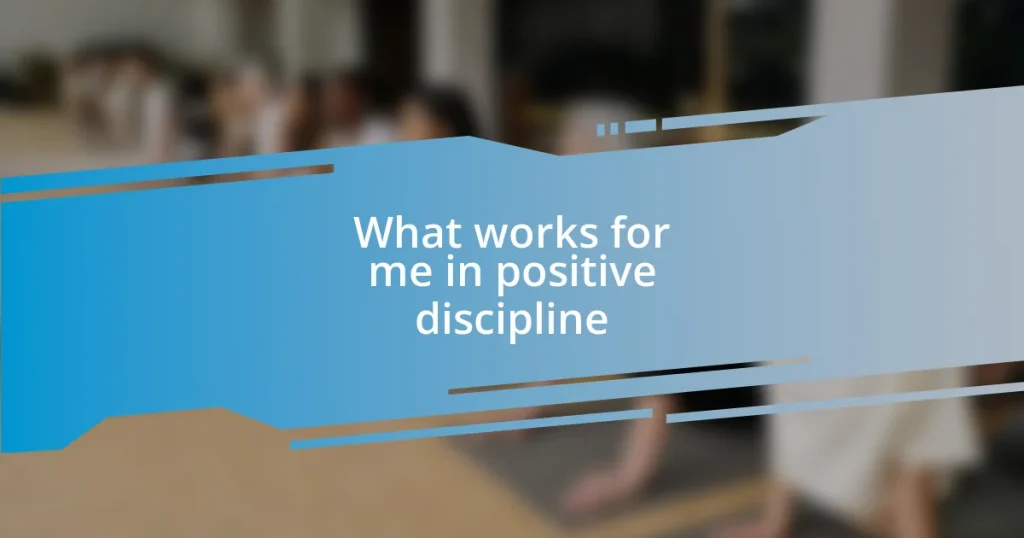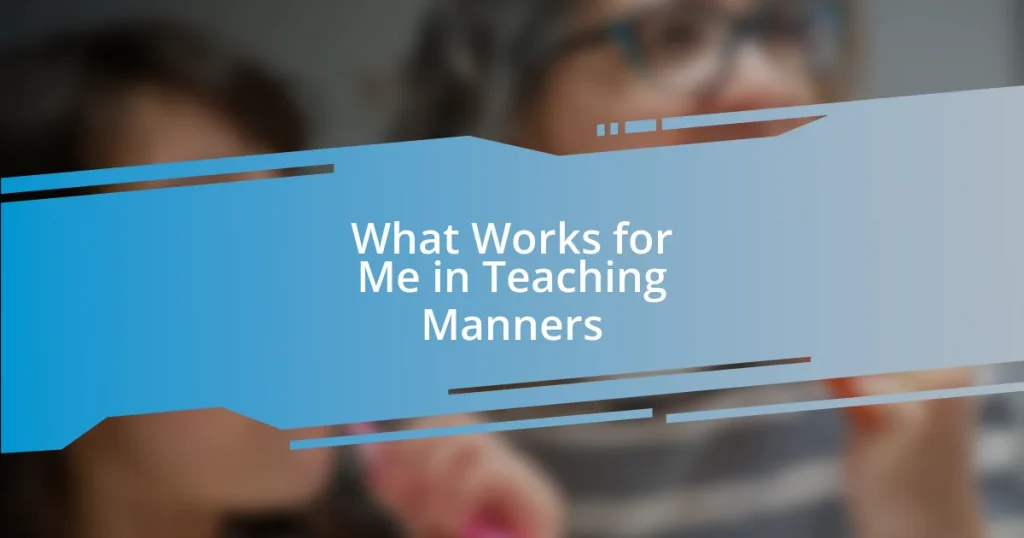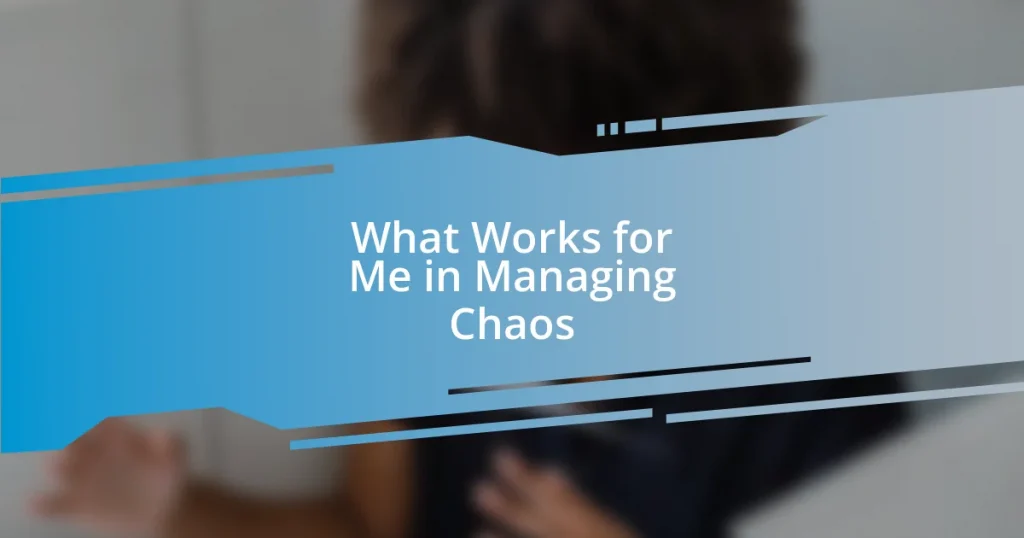Key takeaways:
- Positive discipline enhances emotional expression, problem-solving skills, and strengthens the parent-child bond through open communication and empathy.
- Key principles include encouragement over punishment, fostering independence through conflict resolution, and treating children with respect.
- Effective techniques like active listening, using “I” statements, and setting clear expectations facilitate meaningful interactions and cooperation in children.

Understanding positive discipline benefits
Positive discipline fosters a sense of respect and understanding between parents and children. I remember a time when my son struggled to share his toys with friends. Rather than resorting to punishment, I guided him through the process of expressing his feelings. This approach not only addressed the behavior but also helped him articulate his emotions, teaching him empathy in the process. Isn’t it rewarding when children learn to express themselves instead of feeling reprimanded?
Another benefit I’ve found in positive discipline is that it encourages problem-solving skills. When my daughter faced a conflict during a group project, I resisted the urge to intervene immediately. Instead, I asked her open-ended questions to help her navigate the situation. I was amazed to see how she developed critical thinking and negotiation skills as she resolved it herself. Can you imagine the confidence boost it gave her?
Moreover, positive discipline builds a stronger parent-child bond. I’ve seen firsthand how discussing behaviors and consequences in a supportive way creates a safe space for my kids to share their thoughts. The emotional connection that develops encourages them to approach me with their challenges instead of hiding them. Doesn’t that sound like the kind of relationship we all strive for?

Key principles of positive discipline
One of the key principles of positive discipline is fostering open communication. I vividly recall a moment when my son came to me upset about a friend’s behavior at school. Instead of dismissing his feelings, I encouraged him to share what specifically bothered him. It was amazing to see how just listening and validating his emotions helped him feel respected and understood. Naturally, this not only empowered him but also made our relationship stronger.
- Encouragement over punishment: Shifting focus from punitive measures to encouraging positive behavior can create a more nurturing environment.
- Empathy: Teaching children to understand others’ emotions is vital for their social development.
- Problem-solving: Helping kids learn to resolve conflicts on their own strengthens their independence.
- Consistency: Maintaining a consistent approach ensures kids know what to expect from their behavior and its consequences.
- Respect: Treating children with respect lays the groundwork for mutual understanding in your relationship.
As I continue implementing these principles, I notice a transformation not just in my kids but in myself as a parent. Isn’t it incredible how simply changing our approach can lead to such profound insights for both children and parents alike?

Techniques for effective communication
Techniques for effective communication in positive discipline hinge on some fundamental strategies. One technique that has worked wonders for me is practicing active listening. I recall a day when my daughter stormed into the room frustrated about her homework. Instead of jumping into problem-solving mode, I sat down, made eye contact, and let her vent. You wouldn’t believe how much it helped her just to be heard; she left the conversation feeling lighter and more capable of tackling her tasks.
Another powerful technique is using “I” statements. This approach shifts the focus from blaming to expressing feelings. For instance, instead of saying, “You always leave your things everywhere,” I might say, “I feel overwhelmed when the house is cluttered.” This not only opens a dialogue but also models how to express emotions constructively. Have you ever noticed how changing your wording can shift the entire tone of a conversation?
Finally, I often find that asking open-ended questions creates a space for deeper exploration. I remember when my son struggled with a disagreement with a friend. Instead of telling him what to do, I asked, “What do you think you could say to resolve this?” This technique not only encourages him to think critically but also empowers him to take charge of his relationships. It’s fascinating how these small shifts in communication can foster such meaningful connections.
| Technique | Description |
|---|---|
| Active Listening | Engaging fully with what the child is saying to validate their feelings and thoughts. |
| I Statements | Expressing feelings without assigning blame, thus fostering respectful dialogue. |
| Open-Ended Questions | Encouraging children to think critically and articulate their thoughts and feelings. |

Setting clear expectations with children
Setting clear expectations with children is crucial for helping them understand what is acceptable behavior. I learned this firsthand during a family outing when my daughter began running off in a crowded area. Before stepping out, I took the time to explain the importance of staying close to us for safety. It was surprisingly effective; she not only listened but seemed to appreciate the clarity.
When I set expectations, I try to phrase them positively rather than negatively. Instead of saying, “Don’t run away,” I say, “Please stay with us, so we can all enjoy the day together.” This small shift turns the focus from what they should avoid to what they can do, making compliance feel more achievable. Have you ever noticed how children respond better when they feel included in the rules?
Moreover, I find it beneficial to revisit those expectations regularly. We might chat about them during our meal times, perhaps framing it as a fun family discussion about our outings or activities. It not only reinforces their understanding but also allows for any concerns or questions they may have. Isn’t it amazing how these open lines of communication can transform our interactions, making expectations feel like collaborative agreements rather than strict rules?

Strategies for fostering cooperation
Fostering cooperation often starts with creating a sense of community. In my own experience, family meetings have been a game-changer. We gather around the dinner table, and I share thoughts on how we can support each other. At first, my kids were skeptical, but gradually they opened up, suggesting their ideas. It felt incredible to see their engagement blossom as they took ownership of our family dynamic. Have you ever thought about how powerful it is to let children feel they have a stake in decisions?
Another effective strategy is to utilize teamwork on tasks. I remember one Saturday when my son and I worked together to clean the garage. Instead of treating it as a chore, I framed it as a project we could tackle together. As we sorted through items, I noticed that his spirits lifted, and he began suggesting ways to organize space more efficiently. It’s amazing how shared activities can bring out cooperation naturally, wouldn’t you agree?
Lastly, I find that celebrating small successes together builds a sense of unity and motivation. When my daughter finishes her homework on time, we might reward ourselves with a little movie night. That approach emphasizes teamwork and reinforces the idea that we’re all in this together. It’s these shared milestones that create lasting bonds and encourage ongoing cooperation. Have you ever celebrated a small win and marveled at how it brought everyone closer?

Addressing misbehavior constructively
When addressing misbehavior, it’s important for me to focus on understanding the underlying emotions. I remember a day when my younger child threw a tantrum at the store. Instead of scolding, I knelt down to her level and asked, “Are you feeling frustrated because you can’t have that toy?” Immediately, I could see her calmed down, realizing that her feelings were understood. Isn’t that an eye-opener? Sometimes, all our kids need is a little empathy.
I’ve also learned that clear consequences deliver valuable lessons. One time, my son forgot to pack his lunch and, of course, felt the pangs of hunger at school. Rather than simply telling him “I told you so,” I commented, “Next time, how about we set a reminder together?” This way, he felt empowered to take responsibility without feeling ashamed. It’s these moments of growth that really shape their understanding of accountability, right?
Another approach that works wonders for me is redirecting the behavior into something constructive. There was an instance when my daughter began scribbling with a marker on our living room wall. Instead of losing my cool, I said, “Let’s bring your creativity to the art table instead!” By providing her a different outlet, I channeled her energy into something positive while still addressing the misbehavior. How often do we find that simple redirection not only solves the problem but also strengthens our connection with our children?

Building emotional resilience in children
When I think about building emotional resilience in children, I reflect on the moments when my own kids faced setbacks. There was a time when my daughter didn’t make the dance team she had worked so hard for, and I felt her heartbreak. Instead of brushing it off, I made it a point to sit down with her and talk about failure being a part of growth. Isn’t it fascinating how a simple conversation can transform heartbreak into a stepping stone?
I’ve noticed that teaching kids to express their feelings is vital for their emotional development. Once, during a family hike, my son tripped and fell, leading to tears and frustration. I encouraged him to share what he felt, and through his tears, he told me he was scared he would never make it to the top. It’s moments like these that remind me how important it is to validate their feelings. By allowing kids to articulate their emotions, we empower them to face challenges with more confidence, wouldn’t you agree?
Another technique I’ve implemented is to encourage problem-solving in the face of adversity. Recently, when my son’s plan for a school project fell apart, rather than swooping in to fix it, I asked him, “What do you think we should do next?” He paused, took a deep breath, and started brainstorming options. This process helped him realize he had the capability to figure things out himself. It’s incredible how guiding them toward solutions strengthens their resilience. Have you ever noticed how the right questions can spark a child’s inner strength?
















